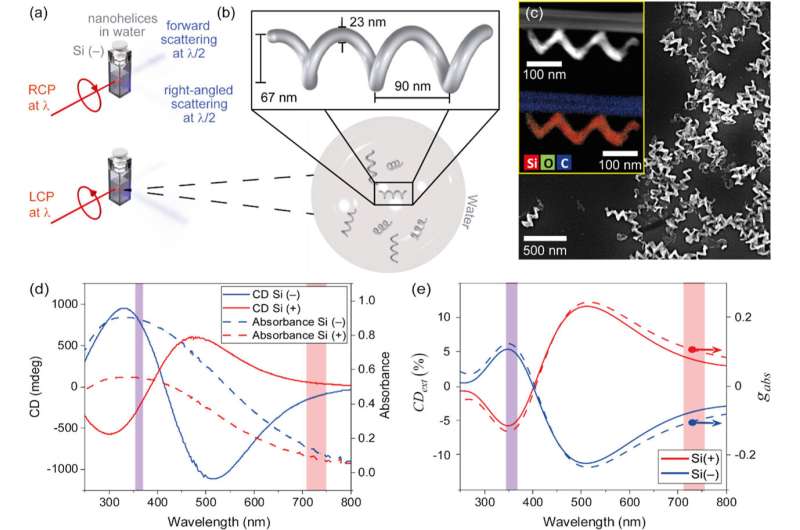
A new nonlinear optical property of tiny particles has been discovered by an international team of scientists led by physicists at the University of Bath, with important implications for researchers working in fields as diverse as display technology, chemical catalysis and medicine.
The new property is seen when light passing through tiny particles—similar in size to the wavelength of light—is scattered at a color that differs from that of illumination. The scattered light is at the “second-harmonic frequency,” meaning it’s at twice the frequency of the illuminating light.
The study, published in ACS Nano, set out to explore the Tyndall effect—the phenomenon of light scattering from particles that are larger than nanoparticles but smaller than microparticles. Particles of this size include viruses and single cell organisms, such as bacteria.
When illuminated with white light, such particles appear blue (blue eyes also owe their color to the Tyndall effect).
Second-harmonic Tyndall scattering
Inorganic particles dispersed in liquids are useful in many applications, including the adding of color to paints and plastics, UV protection creams (zinc oxide and titanium dioxide scatter ultraviolet light but let visible light through), catalysis (to speed up or enable chemical reactions), and medical therapeutics (examples include encapsulating drugs and delivering them to their target; selectively cutting DNA, and killing viruses).
For all these applications, it’s essential for researchers to characterize the particles’ size and shape, accurately and in real-time.
Light is the best method to perform such analysis on particles in water, which is often the medium they are held in. When particles are illuminated, their scattered light holds information about both their size and geometry.
Several methods for analyzing particle size depend on the Tyndall effect. Most methods rely on weak light sources (typically lamps) and the collected scattered light is of the same color as the illumination. Other, more sophisticated methods rely on a laser light source. The new study takes scientists’ understanding of light scattered by laser to the next level.
Explaining, Professor Ventsislav Valev, who led both the Bath team and the study, said, “When a laser—with long light wave—is used in Tyndall’s experiment, light can be created at a different color—with short wave—and then scattered. The new color corresponds to twice the light vibration of illumination.
“This discovery was made in 1965 in the laboratories of Ford Motor Company and applies to particles of all sizes. But if a particle’s size matches the Tyndall effect range, then the illuminating and the newly created light can be better separated in space. Basically, the Tyndall effect sorts light waves by size.
“But one geometrical property has remained unobservable until now with this new study: chirality!”
Twisted molecules
Chirality is a fundamental geometrical property across practically all length scales. In humans and other living organisms, all the functional amino acids are chiral, and so are sugars, proteins, and so on. Chirality is expressed in the direction of a molecule’s twist (clockwise or anticlockwise), akin to the twist of a DNA helix.
For the new study, team members from the United States fabricated silicon helices with length of about 270 nm, which corresponds in size to some viruses, large exosomes and bacteriophages.
Professor Valev said, “We discovered that when we illuminate these helices with chiral (or circularly polarized) laser light, the scattered light can tell us which way silicon helices wind up.
“One reason this is important is because silicon is the most abundant solid element on Earth, so every new property holds potential for sustainable and cost-effective applications.
“Another reason is that measuring twist (chirality) is much needed for assembling inorganic materials from nanotechnological building blocks. The importance is similar to that of making and then being able to measure the thread of a standardized screw.”
Looking ahead, Professor Valev said, “Now that we have a baseline for the properties of single helices in water, the next stage is to start modifying them and eventually building them into self-assembled materials.”
Ph.D. student Ben Olohan, first-author on the research publication, said, “The key here is that biological processes extend from molecules to cell assemblies and beyond. Compared to the length scales of Tyndall scattering, similar effects have been observed for much smaller and for much larger particles.
“So, this intermediate length scale effect had to exist, yet remained unobserved. This is why I kept looking hard for its demonstration. It feels very satisfying for my Ph.D. project, to have found such a ‘missing link’ in science.”
More information:
Ben J. Olohan et al, Chiroptical Second-Harmonic Tyndall Scattering from Silicon Nanohelices, ACS Nano (2024). DOI: 10.1021/acsnano.4c02006
Citation:
Physicists discover a new optical property that measures the twist in tiny helices (2024, June 17)
retrieved 17 June 2024
from https://phys.org/news/2024-06-physicists-optical-property-tiny-helices.html
This document is subject to copyright. Apart from any fair dealing for the purpose of private study or research, no
part may be reproduced without the written permission. The content is provided for information purposes only.







